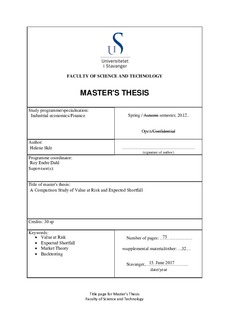| dc.description.abstract | This thesis evaluates the performance of Value at Risk (VaR) and Expected Shortfall (ES) for four portfolios during different scenarios. Both historical VaR and normal VaR together with ES have been calculated for two significance levels, α=1% and α=5%, and two time horizons, h=250 days and h=1000 days. The portfolios represent three commodities markets and a diversified portfolio containing assets from the three markets, grains, energy and metals. Total sample period starts from 2nd of July 2001 until 17th of March 2017 and the scenarios are selected periods during the sample period that have had an influence on the commodity prices. The risk metric performance is evaluated by backtesting the predicted VaR and ES with actual return data. Backtesting has been performed by comparing ratio of violations and observations with significance level, Kupiec test and Christoffersen test.
VaR is a common risk metric tool, and has been implemented in the Basel regulations for financial institutions since the revised Basel I was published in 1996. However, sevarl studies criticize VaR for underestimating risk during times of crisis. During the financial crisis, VaR was unable to predict the severity of the additional loss. This has been investigated for the portfolios in this thesis, and the additional loss was in the worst case 8,4%. Historical VaR is generally better at predicting risk than normal VaR, especially at h=1000 days.
It has been suggested to replace VaR with ES as a standard risk metric for financial institutions that follows the Basel regulations. Thus, the VaR and ES results are compared in order to examine whether ES is a better risk metric, and if ES is able to predict sufficient losses during times of crisis. The results shows that ES is better than VaR to predict losses at high confidence levels. However, during the worst day in the financial crisis, even the best ES metric had an additional loss of 6,1%.
A comparison of the performance to the different portfolios has also been conducted to investigate whether there is a difference between the commodity markets and the diversified portfolios. However, the results shows that there are no significant difference, but the diversified portfolio is generally slightly better in predicting risk. | nb_NO |

